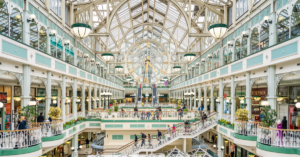This blog was written for the RSA Blog Student Summer Series that will highlight graduate student success in regional studies across the globe throughout the summer.
In line with global trends, Ireland has seen greenhouse gas (GHG) emissions increase with economic growth. As of 2016, road transport accounted for 95% of all transport related CO2 emissions in Ireland.

© Dawid K Photography – Shutterstock
While the scale of these disturbing figures can be inconceivable, individuals still consider ways to reduce their carbon footprint in throughout their daily life. For Ireland, car-dependency inflates harmful GHG emissions, so it is possible to imply that one solution is for individuals to reduce their driving time. However, who truly holds the power to make change? This article argues that the power lies with policy-makers.
Urban sprawl, suburban shopping, and environmental impacts
Decades past, suburban living was often the goal that many urbanites worked towards, given the pull toward the ‘American Dream’ and white picket fences. But today, evidence suggests that growing urban sprawl represented by suburbs is unsustainable and ultimately detrimental to the environment.
The emergence of suburbs traces back to the development and accessibility of the modern car. Personal cars allowed the working class to work in the city but live further away, without significantly adjusting their morning alarm. Inevitably, suburbs have become congested with poor public transport links and are generally too distant to consider walking or cycling regularly. When people leave the cities to live in suburbs, personal vehicles tend to be the main form of transport. My research asks: Does this trend persist even when businesses re-locate outside of cities to join suburban communities? It appears so.
By assuming people go to work and to shops using the same transport mode, I was able to analyse hypothetical shopping trips in Ireland’s five major cities. I decided which shopping centre people would go to, based on two factors:
1) Travel time
2) Shopping centre size.
My assumption was that people want to go to their nearest, biggest shopping centre. I expose where shopping centres generate the most and the least emissions and also show which areas are accessible/inaccessible by car, bus, walking and cycling.
Unsurprisingly, this research found that shopping centres that are most accessible by car generally become inaccessible when walking, cycling and taking the bus – encouraging car use. An effect most clearly observed outside of cities, this confirms the hypothesis that cars dominate the transport hierarchy for consumers accessing shopping centres.
As a result, the suburban shopping centres selected for this project produced >85% of all estimated emissions. The total estimated emissions figure, for car use, accounts for ~9% of the monthly contribution to the road transport emissions figure you saw at the start of this piece, whereas the same figure for buses accounts for ~0.008%. Clearly then, attempting to balance regional transport hierarchies by encouraging the development and use of public transport and walking/cycling infrastructure offers great potential. Policies which make developers pay for car-dependency and inaccessibility have produced promising results to this effect. Making shopping centres accessible to bus users, walkers and cyclists, then, could be the first step in alleviating congestion and the troublesome emissions generated by the transport sector.
Unsurprising again, this research found that shopping centres within cities are relatively more accessible to walkers and cyclists than those located outside cities. This is because of the dense, walkable nature of these areas. Also, we discover that catering to one active transport mode, like walking, generally caters to both, highlighting a cost-effective way of developing sustainable transport infrastructure. Businesses like shopping centres can benefit communities by increasing employment, accessibility to necessities and leisure, but do not come without challenges. Our research illustrates that suburban shopping centres can create extensive congestion and evidently worsen existing emission levels, depending on where they are located.
Prioritizing accessible, ‘green,’ infrastructure should be on policymakers agenda
Congestion and excessive car use are can be compared to bread and butter. Meaning, a solution to both of these problems lies in reducing the number of cars on the road by making shopping centres convenient to transport other than cars. Like buses.
Frequent and reliable public transport systems reduce the impacts of car-dependency, and subsequently, congestion. Evidence also suggests that given the chance to travel sustainably, people generally will – prompting a call to ‘let us!’ and a win-win situation for public health and environmental impact. Public transport reduces CO2 emissions by generally easing congestion and reducing the number of vehicles on the road, if adopted at a big enough scale, with walking and cycling carrying additional health benefits.
Above all, this research provides evidence for policymakers, advocating for compact, walkable, accessible infrastructure development as a possible contribution to pursue long-term emission reductions by encouraging greater sustainable transport usage and development.

Conor O’Driscoll (Twitter @conorodriscollx) is a first year PhD candidate from Cork, Ireland, studying the environmental impact of sprawled developments in the Spatial and Regional Economic Research Centre at the University College Cork (UCC), Ireland.
Are you currently involved with regional research, policy, and development? The Regional Studies Association is accepting articles for their online blog. For more information, contact the Blog Editor at rsablog@regionalstudies.org.